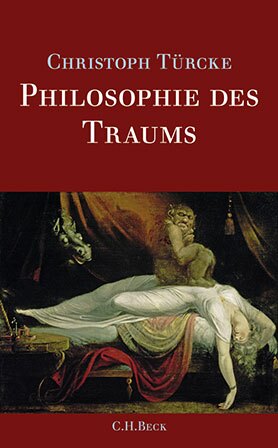Christoph Türcke
Philosophie des Traums
[The philosophy of dreams]
- C.H.Beck Verlag
- Munich 2008
- ISBN 978-3-406-57637-9
- 240 Pages
- Publisher’s contact details
Christoph Türcke
Philosophie des Traums
[The philosophy of dreams]
Published in Portugiesisch (Bras.) with a grant from Litrix.de.
Sample translations
Review
In three long chapters, ‘Dream’, ‘Drive’ and ‘Word’, the Leipzig philosophy teacher unfolds the panorama of this history of civilization. Sigmund Freud’s decoding of dreams provides him with his system of coordinates but in many respects Türcke goes beyond the founder of psychoanalysis and probes the fractures in Freud’s work, exploring insights that transcend the established tenets of psychology. He begins, however, by paying attention to ‘the Paleolithic Age in us’, as he puts it, ‘that sediment of thought in Homo Sapiens deposited by millennia of laborious refinement of the nerves’. The hominids, who gradually learned how to give rocks a sharp edge in the course of painstaking, dedicated labour, shifted their attention from food to tools – this was a crucial displacement of instinctual energy, a training in endurance that was constantly refined over millions of years until it finally produced the first traces of culture. In the course of this struggle for survival, the physical attributes of Homo sapiens developed – his large brain and manual dexterity that go hand in hand with the deferred gratification of his instincts.
‘Condensation’ and ‘displacement’, the two central concepts of Freud’s Interpretation of Dreams, also serve as leitmotifs of Türcke’s philosophical approach. In the chapter headed ‘Dream’ he shows how Freud’s use of potent metaphors enables him to transpose the process of dreaming into an entirely new cultural setting. ‘Condensation’ and ‘displacement’ are the two ‘master processes’ that allow us to smuggle a particular motif past the ‘censor’ and into the dream and in that way to process material that is not amenable by the light of day. However, Freud was himself constrained to revise his thesis that dreams are wish-fulfilments. Soldiers traumatized in the First World War spoke a different language and this led Freud to introduce the death instinct into his theory. Soldiers returning home from the front found themselves experiencing a traumatic repetition compulsion. Their nervous system attempted to exorcise their terror by repeating it; they hoped to get rid of it by internalizing it. It is at this point that Türcke’s path diverges from Freud’s.
According to Türcke, there is something more fundamental than the erotic. It is the drive to escape from terror. And culture too may be said to have arisen from such repetition compulsions. Why do we assume the arduous burdens of culture, why are we so concerned to invent meanings, if we could manage without all that? ‘No drive-motivated being acts in this way from pure pleasure or out of caprice’, Türcke writes. He surmises that early collectives of hominids may well have reacted in a similar way to bad weather and wild animals, that is to say, they repeated the forces of nature by performing ritual sacrifices. The sacrifice is the earliest form of traumatic repetition compulsion. It represents the condensation and displacement of the terrors of nature – a mechanism that Freud believes originates with dreams. Stoning people to death, human sacrifices, burials – the first rituals arise from the traumatic compulsion to repeat, which at first does away with only the most unbearable excessive stimuli.
At key points of his history of civilization Türcke identifies an unbearable suffering, a terror that cannot be endured, and in this way he arrives at an utterly gory view of the humanization process. Everything is always deadly serious; the drives that lead mankind to achieve something new are seldom friendly or pleasurable. Sexuality can become the central driving force only after stoning and human sacrifices have done their worst. Sex is initially a symbol of something else, as Türcke shows in connection with the Gilgamesh Epic.
The process of condensing, displacing and reversing external terror unleashes the power of the imagination and also, in its wake, of language – it is the physiological activity of the nerves that drives human beings into taking further steps. But what exactly are drives? In his chapter on ‘drives’, Türcke ventures onto neurological terrain. He describes how nerve streams carve out paths, while fixed paths come into being. And in this original structure of repetition he perceives a physical prototype of the repetition compulsion that creates early ritual structures. One of his basic ideas here is once again that fear is the central motive force underlying the creation of human beings. Freud’s conception of the death instinct, which casts doubt on the validity of the pleasure principle, turns out to be no more than a spurious solution, in Türcke’s view. He prefers to install pain at the inception of the history of mankind. Unbearable pain is transformed by the traumatic compulsion to repeat into the cult of human sacrifice – ritual killings, in other words. This marks the beginnings of the history of the human mind.
In his chapter on ‘Words’ Türcke supplies the third pillar of his philosophy of dreams. The primitive imagination can only develop into true human mental activity if it is transformed into language. And here too we see terror at work: ‘The driving force behind the formation of sounds was traumatic shock, whose excess stimulation is on the lookout for ways out. One such way out is to emit sounds. People attempt, as it were, to expel the shock itself, to expunge it from their own organism.’ Words, then, start off as ‘exorcists’ that seek to ‘expel their cause, terror, entirely’. Türcke goes on to develop a complex linguistic theory or rather, a prehistory of language. That begins by naming the sacred, an action that converts terror into a protective power. This act of naming succeeds, over immense periods of time, in gradually endowing language with a grammatical structure.
The treatment of the final stage of Türcke’s archaeology of the mind, the ‘high-tech dreamtime’, is unfortunately somewhat compressed and given an inflection in the direction of cultural pessimism. The invention of film marks a historical caesura – it makes excessive demands on the human eye and man’s capacity to perceive in general. This downward spiral is constantly intensified by the world of our digital screens which deliver an unending series of visual shocks. Türcke fears for our basic ability to ‘dwell on things’, to process external impressions slowly and hence for our patience and dedication. ‘These dreamlike, hallucinatory sequences of images, ceaselessly broadcast by a global apparatus, make our living capacity to dream appear literally old, the images our dreams produce appear feeble in comparison and their entire activity seems to lag behind.’ He had argued along the same lines in his earlier book Erregte Gesellschaft, Philosophie der Sensation (2002) [Agitated Society, Philosophy of Sensation]. There he had warned about the flood of stimuli and the permanent state of over-excitement. However, these are the classical clichés dragged in whenever new media make their appearance. The truth is that printed books, novels, the radio and other inventions that begin by triggering panic demonstrate that the world does not come to an end; it just becomes a little less transparent.
The fact that The Philosophy of Dreams is speculative in some of its crucial passages can be seen as pure gain. After all, rehabilitating speculating as a philosophical method is precisely what Türcke sets out to do. We do not need to endorse every aspect of his attempt to explain the whole of culture as the product of the terror of killing– from human sacrifice via burial rites and on to the incest taboo and even right down to the creation of music. There are other theories which explain human development in less bloodthirsty terms. Nevertheless, The Philosophy of Dreams makes for riveting reading (we may draw attention in particular to the passages where he trashes Chomsky’s universal grammar and Lacan’s poststructuralist phallocracy). Türcke confronts us with the major questions without getting sidetracked in evolutionary, sociobiological, utilitarian or other one-dimensional explanations. How hominids became human beings or, to put it even more bluntly, what human beings ‘are’, are still great unknowns and they cannot be decoded simply by methods drawn from either the natural sciences or the humanities on their own.
Freud chose a verse from Virgil’s Aeneid as his motto: ‘Flectere si nequeo superos, Acheronta movebo’ (‘If Heaven I cannot bend, then Hell I shall arouse’). Türcke for his part turns Freud into the Virgil who will guide him through the underworld of dreams. And anyone who lets himself be guided by The Philosophy of Dreams can look forward to an exacting, but also an original and inspiring journey through the night.
Translated by Rodney Livingstone

By Jutta Person
Jutta Person, born 1971 in South Baden, studied German, Italian and Philosophy in Cologne and Italy, and gained a doctorate with a dissertation on the history of physiognomy in the 19th century. A journalist and cultural commentator, she is based in Berlin and writes for the Süddeutsche Zeitung, Die Zeit and Philosophie Magazin. From 2004 to 2007 she was an editor at Literaturen; since 2011 she has been in charge of the books section at Philosophie Magazin.
(Updated: 2020)
